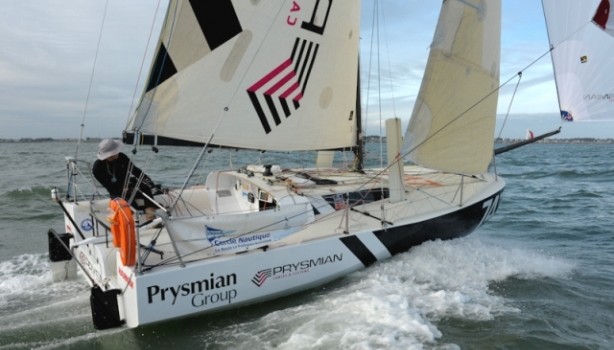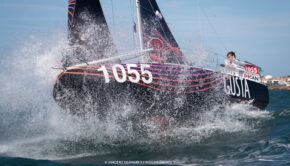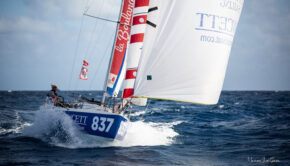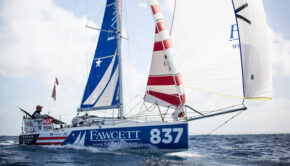Mini Transat: Time to decide at Puerto Calero
Published on November 17th, 2013
(November 17, 2013) – One after the other the competitors in the Mini Transat are approaching Lanzarote and Puerto Calero, the aborted stopover point of this edition. Despite the lack of an official stopover, our Calero family and the staff of the marina remain on standby waiting for any pit stops, the first of which came this morning with Nicolas Boidevezi (Nature Addicts). Accepting the loss of 12 hours in order to be able to gain later is just one of the dilemmas that face the competitors before the big crossing.
While passing through the gate at Puerto Calero represents only a quarter of the total distance of the Mini Transat, it none the less has huge symbolic significance. This is the beginning of the trade winds, and one of the last opportunities to make a pit stop before setting off for nearly two weeks at sea with no escape.
This is also the first time the competitors are faced with a significant choice of route. Is it better to head south and go in search of the more established, stronger trade winds. Alternatively, will it be more profitable to sail the most direct route. The only information the competitors have access to is the weather reports provided by the organisation that allow them to position the major weather systems, and from which they must determine their strategy for the coming days.
Investing in one route
For the Ministes this course is an initiation test, as for the last ten years the path across the Atlantic led them to Brazil. Even for repeat offenders, this is a new challenge to be faced. Only the racing experience of the annual Atlantic crossings with events such as the Figaro circuit can give them some clues. If they rely on simple statistics, going south seems to be the more sensible choice. However, those crossings take place in the spring and not on the edge of winter. So they have to choose sides and know how to be opportunistic.
Taking a loss to make a gain?
The second element of choice is whether to stop at Puerto Calero or continue directly on the journey. The Regulations require that any call should last a minimum of 12 hours and a maximum of 72. At the level of an Atlantic crossing a twelve hours stop can be recovered. So which one is better? Stop and then come out with the boat at full potential, but lose half a day, or decide that minor damage can be managed at sea and a call isn’t necessary? Added to this, the psychological factor may be decisive. After four days of racing where the soloists have taken a good thrashing, the temptation to stop can be dangerous. The risk of loosing your racing rythme is real and the desire to restart can quickly wane. The determination to cross must be deeply ingrained and they must be sure they have the ability to bounce back before deciding on a pit stop. Nicolas Boidevezi is already in port and others have announced their intention to stop for repairs including David Genest (Bingo), Rafaëla Le Gouvello (respectocean.com), Yoann Tricault (Schlüter Systems), Erwan Pellen (Mordilou) and Julien Pulvé (MEXT – ICA). In contrast, others have made - the choice not to break their rhythum and to stay with the competition. These include Simon Koster (Go 4 it), who will climb the mast to work on his aerial, and Rémi Fermin (Boreal). Clinging on to a great fifth place in the prototypes, Remi is also the architect and builder of his boat and has decided, despite the failure of his fuel cell, to continue on his journey, trusting to his solar panels for power. It took uncommon tenacity for him to make it to the start, and he will not be stopped in his quest by this type of equipment issue.
Ranking (prototypes) at 16.00 (GMT +1)
1. Giancarlo Pedote (747 – Prysmian) with 2673.6 nm to the finish
2. Bertrand Delesne (754 – TeamWork Proto) + 17.9 nm
3. Benoit Marie (667 – benoitmarie.com) + 25.3 nm
4. Nicolas Boidevezi (719 – Nature Addicts) + 65.2 nnm
5. Rémi Fermin (741 – Boréal) + 71.5 nm
Ranking (series boats) at 16.00 (GMT +1)
1. Aymeric Belloir (810 – Tout le Monde chante contre le Cancer) with 22726.2 nm to the finish
2. Simon Koster (819 – Go 4 it) + 7.5 nm
3. Justine Mettraux (824 – TeamWork) + 23.5 nm
4. Renaud Mary (535 – www.runo.fr) + 47.4 nm
5. Jean-Baptisste Lemaire (607 – uvre du Marin Breton) + 61.2 nm
Event media reporting
Background: The biennial Mini Transat is a transatlantic race for solo Mini 6.5m competitors. The race has two legs: 1257 miles from France to Canary Islands, and 2764 miles from Canary Islands to Guadeloupe. Demand is high to compete. The race is limited to 84 racers, and each entrant must fulfill qualifying requirements. The race has a production division and a prototype division.
The start from Douarnenez was originally planned for October 13, but was postponed due to severe weather conditions on the race course. A weather window allowed for the start of the first leg of the Mini Transat 2013 on October 29, but worsening weather conditions forced the cancellation of this leg and the Mini Transat fleet found shelter in the ports on the north coast of Spain.
The fleet, now reduced to 73 competitors, restarted in Sada, Spain on November 13, with the race reduced to one 3700 mile leg direct to Pointe-à-Pitre.
Race website: http://www.minitransat.fr/









 We’ll keep your information safe.
We’ll keep your information safe.